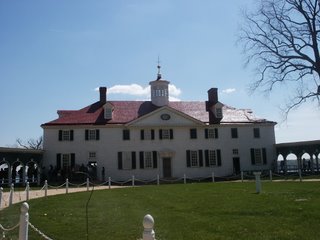
Temperatures in the 60s, birds happily heralding “Spring,” and the wide Potomac gloriously flowing past George Washington’s back porch create a terrific way to spend a day at Mt. Vernon, the home he loved, nourished and tended in all its intricacies for fifty years.
Historic homes are often interesting, but seeing period furniture and room design begins to wear after a while. The interesting journey at Mt. Vernon is one in perspective. I get to know Washington in his own time, and if I look deeply enough, I gain insight into his 18th century character.
As an example, Washington installed “The Necessary,” an outdoor privy. No question about the selection of name. These privies collected wastes in central locations and provided fertilizer for the fields. Washington understood the efficacy of personal hygiene, the lack of which provoked his intense disdain for the sloppy and dirty New Englanders he met in the early days of the Revolution. While disease and fever plagued the American Army, the Red Coat camps were virtually free of camp fever because of stringent sanitary practices. Washington understood, having served in the highly regimented British Army.
How did he become a farmer? Washington fought in the French and Indian War, but as a colonial he was repeatedly denied advancement in the British Army. His resignation led to farming, marriage and to building Mt Vernon into an 8,000 acre business. When he first inherited Mt. Vernon, it was little more than a cabin, but the mansion he left is impressive and reflects a profound knowledge and creativity.

The exterior of the mansion utilizes a technique called rustication: the wooden exterior takes on the look of stone. I won’t go into the method here, but I will show you what it looks like. It reminds me of a Garden State Brickface façade, but in the 18th century, rustification was sophisticated and extraordinarily labor intensive.
Don't mistake Washington for a "home grown" American boy. Aristocratic George looked to Europe for fashion. His elaborate gardens, farm, and orchards were managed by gardeners trained in Europe but able to take advantage of the abundance of America.
Inside the mansion, the 18th century male prevailed. George Washington had ultimate control, a characteristic he had to grow into during the early days of the Revolution where mistakes were made because of indecision. The only rooms decorated by Martha Washington were their private living quarters, removed, for privacy, from the main part of the mansion. Everything else was chosen by Washington, and much of the decoration follows a farming theme. Most of the furniture and decorations were imported from Europe.
Mt. Vernon is beautiful. The piazza overlooks the Potomac, and the views are stunning. A tour
 demonstrates the way labor was divided in order to make this business run smoothly and well. The farm demonstrates Washington’s uncommon interest in modern agricultural methods as well as his foresight. The same foresight echoed in his presidency. Consider:
demonstrates the way labor was divided in order to make this business run smoothly and well. The farm demonstrates Washington’s uncommon interest in modern agricultural methods as well as his foresight. The same foresight echoed in his presidency. Consider:- In his will he freed his slaves, although he used slave labor throughout his own life
- He refused to serve a 3rd term, feeling the need for change. It took the country 200 years before that became law
In 1858 for $200,000, the Mount Vernon Ladies’ Association purchased about 500 acres, including the mansion, from a Washington descendant . I asked one docent about the condition at that time, fewer than fifty years after Washington's death. The building was in total disrepair. The association continues to restore, do archeological research and bring Washington’s eminence to the public. Under construction is a complex that will become a museum and learning center for the Father of our Country.
 One point to consider when visiting Mt. Vernon—there was a long waiting line to take the mansion tour. A docent told us that the length was unusual for a weekday but not for a weekend. So be prepared. Try to visit on a weekday and come early. Schools visit, but the preponderance of school busses seemed to arrive around noon. We arrived at 11:30 and there were relatively few busses then. Other busses are charter tour busses.
One point to consider when visiting Mt. Vernon—there was a long waiting line to take the mansion tour. A docent told us that the length was unusual for a weekday but not for a weekend. So be prepared. Try to visit on a weekday and come early. Schools visit, but the preponderance of school busses seemed to arrive around noon. We arrived at 11:30 and there were relatively few busses then. Other busses are charter tour busses.
There is an admission charge, but you will find touring Mt. Vernon well worth the price.

